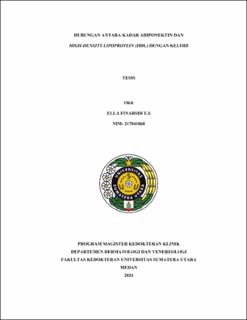Hubungan Antara Kadar Adiponektin dan High-Density Lipoprotein (HDL) dengan Keloid
Correlation between Adiponectin and High-Density Lipoprotein Levels and Keloid

Date
2024Author
S, Ella Finarsih E
Advisor(s)
Putra, Imam Budi
Wardani, Meidina Kesuma
Metadata
Show full item recordAbstract
Background: Keloid is a pathological skin condition characterized by excessive proliferation of scar tissue following injury. Although the pathophysiological mechanisms of keloid are not yet fully understood, molecular factors such as adiponectin and high-density lipoprotein (HDL) are suspected to play a role in keloid development. Adiponectin is an adipokine known for its anti-inflammatory and anti-fibrotic effects, while HDL is involved in lipid metabolism and modulation of the inflammatory response.
Objective: To determine the correlation between adiponectin and HDL levels and keloid.
Subjects and Methods: This study is an observational analytic study with a cross-sectional method involving 40 keloid patients and 40 non-keloid individuals. Each patient underwent anamnesis, dermatological examination, followed by blood sampling to assess adiponectin and HDL levels using ELISA testing. The data were analyzed using the Chi-square test and considered significant if p<0.05.
Results: Keloids were more common in females and within the age range of 18–25 years. Most subjects had a middle level of education and no family history of keloid. The distribution of adiponectin and HDL levels in keloid patients was predominantly low (82.5% and 87.5%, respectively). This study found a significant relationship between adiponectin and HDL levels and keloid (p=0.026 and p=0.018).
Conclusion: There is a correlation between adiponectin and HDL levels and keloid.
